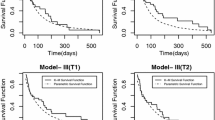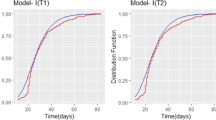Abstract
We propose bivariate Weibull regression model with frailty in which dependence is generated by a gamma or positive stable or power variance function distribution. We assume that the bivariate survival data follows bivariate Weibull of Hanagal (Econ Qual Control 19:83–90, 2004; Econ Qual Control 20:143–150, 2005a; Stat Pap 47:137–148, 2006a; Stat Methods, 2006b). There are some interesting situations like survival times in genetic epidemiology, dental implants of patients and twin births (both monozygotic and dizygotic) where genetic behavior (which is unknown and random) of patients follows known frailty distribution. These are the situations which motivate to study this particular model.
Similar content being viewed by others
References
Block H.W., Basu A.P. (1974) A continuous bivariate exponential extension. J Am Stat Assoc 69: 1031–1037
Clayton D.G. (1978) A model for association in bivariate life tables and its applications to epidemiological studies of familial tendency in chronic disease incidence. Biometrika 65:141–151
Fan J.J., Hsu L., Prentice R.L. (2000) Dependence estimation over a finite bivariate failure region. Lifetime Data Anal 6:343–355
Fine J.P., Glidden D.V., Lee K.E. (2003) A simple estimator for a shared frailty regression model. J R Stat Soc B 65:317–329
Freund J.E. (1961) A bivariate extension of exponential distribution. J Am Stat Assoc 56:971–77
Glidden D.V. (1999) Checking the adequacy of the gamma frailty model for multivariate failure times. Biometrika 86:381–394
Gumbel E.J. (1960) Bivariate exponential distribution. J Am Stat Assoc 55:698–707
Haas R., Mensdorff-Pouilly N., Mailath G., Watzek G. (1996) Survival of 1,920 IMZ implants followed for up to 100 months. Int J Oral Maxillofac Implants 11:581–588
Hanagal D.D. (1996) A multivariate Weibull distribution. Econ Qual Control 11:193–200
Hanagal D.D. (2004) Parametric bivariate regression analysis based on censored samples: A Weibull model. Econ Qual Control 19:83–90
Hanagal D.D. (2005a) A bivariate Weibull regression model. Econ Qual Control 20:143–150
Hanagal D.D. (2005b) A positive stable frailty regression model in bivariate survival data. J Ind Soc Probab Stat 9:35–44
Hanagal D.D. (2006a) Bivariate Weibull regression model based on censored samples. Stat Pap 47:137–148
Hanagal DD (2006b) Weibull extensions of bivariate exponential regression model for a survival data. Stat Methods (to appear)
Hanagal D.D. (2006c) Weibull extension of bivariate exponential regression model with gamma frailty for survival data. Econ Qual Control 21:165–174
Hougaard P. (2000) Analysis of multivariate survival data. Springer, New York
Ivanoff C.T., Grondahl K., Sennerby L., Bergstorm C., Lekholm W. (1999) Influence of variations in implant diameters: a 3 to 5 year retrospective clinical report. Int J Oral Maxillofac Implants 14:173–180
Lee L. (1979) Multivariate distributions having Weibull properties. J Multivariate Anal 9:267–277
Liang K-Y (1991) Estimating effects of probands characteristic in familial risk: 1. Adjustments for censoring and correlated ages at onset. Genet Epidemiol 8:329–338
Lu J.C. (1989) Weibull extensions of the Freund and Marshall–Olkin bivariate exponential models. IEEE Trans Reliabil 38:615–619
Marshall A.W., Olkin I. (1967) A multivariate exponential distribution. J Am Stat Assoc 62:30–44
Oakes D. (1982) A model for association in bivariate survival data. J R Stat Soc B 44:414–422
Oakes D. (1986) Semiparametric inference in bivariate in bivariate survival data. Biometrika 73: 353–361
Oakes D. (1989) Bivariate survival models induced by frailties. J Am Stat Assoc 84:487–493
Parner E. (1998) Asymptotic theory for correlated gamma-frailty model. Ann Stat 26:183–214
Proschan F., Sullo P. (1974) Estimating the parameters of bivariate exponential distributions in several sampling situations. In: Proschan F., Serfling R.J. (eds). Reliability and biometry. SIAM, Philadelphia, pp 423–440
Shih J.H. (1998) A goodness-of-fit test for association in a bivariate survival model. Biometrika 85:189–200
Author information
Authors and Affiliations
Corresponding author
Additional information
David D. Hanagal is on leave from Department of Statistics, University of Pune, Pune 411007, India.
Rights and permissions
About this article
Cite this article
Hanagal, D.D. Weibull extension of bivariate exponential regression model with different frailty distributions. Stat Papers 50, 29–49 (2009). https://doi.org/10.1007/s00362-007-0057-4
Received:
Revised:
Published:
Issue Date:
DOI: https://doi.org/10.1007/s00362-007-0057-4




